![]()
![]()
![]()
Use LEFT and RIGHT arrow keys to navigate between flashcards;
Use UP and DOWN arrow keys to flip the card;
H to show hint;
A reads text to speech;
165 Cards in this Set
- Front
- Back
|
tissues |
groups of cells that are similar in structure and perform a common or related function
|
|
|
tissues
|
groups of cells that are similar in structure and perform a common or related function |
|
|
1. nervous 2. muscle 3. epithelial 4. connective |
4 types of tissues
|
|
|
nervous tissue
|
tissue type responsible for internal communication; "controls" |
|
|
muscle tissue
|
tissue type that contracts to cause movement; "produces movement" |
|
|
epithelial tissue |
tissue type that forms boundaries between different environments, protects, secretes, absorbs, filters; "covers" |
|
|
connective tissue
|
tissue type that supports, protects, binds other tissues together; "supports" |
|
|
histology |
the study of tissues |
|
|
1. fixed (preserved) 2. sectioned (sliced) 3. stained |
3 steps before a specimen can be observed with a microscope |
|
|
artifacts
|
minor distortions of preserved tissue on a microscopic slide |
|
|
1. covering/lining 2. glandular |
2 main classes of epithelial tissue |
|
|
covering and lining epithelium
|
main class of epithelium forming the outer layer of the skin; lines open cavities; covers walls and organs of the closed ventral body cavity |
|
|
glandular epithelium
|
main class of epithelium that forms the glands of the body |
|
|
1. polarity 2. specialized contacts 3. supported by connective tissue 4. avascular but innervated 5. regeneration |
5 special characteristics of epithelium |
|
|
1. apical surface 2. basal surface |
2 surfaces of all epithelia: |
|
|
apical surface
|
an upper free surface exposed to the body exterior or the cavity of an internal organ |
|
|
basal surface
|
a lower attached surface of epithelia |
|
|
brush border
|
dense area of microvilli |
|
|
basal lamina
|
thin, noncellular supporting sheet below the epithelium that acts as a filter for molecules entering from below |
|
|
reticular lamina
|
layer of connective tissue deep to the basal lamina containing collagen protein |
|
|
basement membrane
|
reinforces the epithelial sheet, resists stretching, and defines the epithelial boundary; includes the basal lamina and reticular lamina |
|
|
avascular
|
containing no blood vessels |
|
|
innervated
|
supplied by nerve fibers
|
|
|
1. simple 2. stratified |
2 types of epithelial layers |
|
|
1. squamous 2. cuboidal 3. columnar |
3 types of epithelial cells |
|
|
simple epithelia
|
epithelia found where absorption, filtration, and secretion occur; consist of a single layer |
|
|
stratified epithelia
|
epithelia found in high-abrasion areas, where protection is important; consist of two or more cell layers stacked |
|
|
squamous cells
|
flattened and scalelike epithelial cells; diffusion and filtration |
|
|
cuboidal cells
|
boxlike epithelial cells; secretion and absorption |
|
|
columnar cells
|
tall and column shaped epithelial cells; secretion and absorption, often contain cilia and microvilli |
|
|
1. simple squamous epithelium 2. simple cuboidal epithelium 3. simple columnar epithelium 4. pseudostratified columnar epithelium 5. stratified squamous epithelium 6. stratified cuboidal epithelium 7. stratified columnar epithelium 8. transitional epithelium |
8 types of epithelium |
|
|
simple squamous epithelium
|
thin and permeable epithelium found where filtration or the exchange of substances by rapid diffusion is a priority
|
|
|
1. endothelium 2. mesothelium |
2 special types of simple squamous epithelium |
|
|
endothelium
|
special type of simple squamous epithelium providing a slick, friction-reducing surface in lymphatic and blood vessels |
|
|
mesothelium
|
special type of simple squamous epithelium found in serous membranes
|
|
|
simple cuboidal epithelium
|
epithelium that secretes and absorbs, found in smallest gland ducts and in many kidney tubules |
|
|
simple columnar epithelium
|
epithelium lining the digestive tract, mostly concerned with absorption and secretion; often contain microvilli and tubular glands |
|
|
pseudostratified columnar epithelium
|
epithelium that secretes substances, particularly mucus; nuclei lie on different levels |
|
|
stratified squamous epithelium
|
most widespread stratified epithelium, found in areas subject to wear and tear; external part of the skin and body openings
|
|
|
stratified cuboidal epithelium
|
rare epithelium found in some of the larger glands
|
|
|
stratified columnar epithelium
|
rare epithelium found in the pharynx, male urethra, and some glandular ducts
|
|
|
transitional epithelium
|
epithelium forming the lining of hollow urinary organs that stretch
|
|
|
gland
|
consists of one or more cells that make and secrete a particular product; contain many Golgi complexes (for secretion) |
|
|
secretion
|
an aqueous fluid produced by glands |
|
|
1. endocrine 2. exocrine |
2 classes of glands (by location)
|
|
|
endocrine glands
|
internally secreting glands; ductless
|
|
|
exocrine glands
|
glands that secrete their products onto body surfaces or into body cavities |
|
|
1. unicellular 2. multicellular |
2 classes of glands (by number of cells) |
|
|
unicellular exocrine glands
|
single-celled glands sprinkled throughout the intestinal and respiratory tracts amid columnar cells with other functions |
|
|
mucin
|
complex glycoprotein secreted by unicellular glands that dissolves in water and becomes mucus |
|
|
goblet cells
|
cuplike exocrine glands in the intestinal tract that secrete mucin |
|
|
mucous cells
|
unicellular exocrine glands of the respiratory tract |
|
|
multicellular glands |
exocrine glands with both a duct and a secretory unit (acinus)
|
|
|
1. simple 2. compound |
2 main types of multicellular exocrine glands |
|
|
simple glands |
exocrine glands with a single, unbranched duct |
|
|
compound glands |
exocrine glands with branched ducts |
|
|
1. tubular 2. alveolar (acinar) 3. tubuloalveolar |
3 types of multicellular exocrine glands (by cell shape) |
|
|
tubular
|
tube-shaped secretory cells of a multicellular exocrine gland
|
|
|
alveolar (acinar) |
sac-shaped secretory cells of a multicellular exocrine gland
|
|
|
tubuloalveolar
|
multicellular exocrine gland with both tube- and sac-shaped secretory cells
|
|
|
1. merocrine 2. holocrine 3. apocrine |
3 modes of secretion of multicellular exocrine glands
|
|
|
merocrine glands
|
multicellular exocrine glands that secrete their products by exocytosis as they're produced; ex. pancreas, sweat glands, salivary glands |
|
|
holocrine glands |
multicellular exocrine glands that accumulate their products within them until they rupture; sebaceous (oil) glands of the skin
|
|
|
apocrine glands
|
multicellular exocrine glands that accumulate their products just beneath the surface before pinching off; uncommon in humans
|
|
|
connective tissue
|
the most abundant and widely distributed of the primary tissues |
|
|
1. connective tissue proper 2. cartilage 3. bone 4. blood |
4 main classes of connective tissue
|
|
|
1. support 2. protection 3. insulation 4. fuel storage 5. transportation |
5 major functions of connective tissue |
|
|
1. common origin (mesenchyme) 2. degrees of vascularity 3. extracellular matrix |
3 common characteristics of connective tissue |
|
|
mesenchyme
|
common embryonic origin of connective tissues |
|
|
extracellular matrix
|
consists of ground substance and fibers; connective tissue is mainly comprised of this
|
|
|
1. ground substance 2. fibers 3. cells |
3 main elements of connective tissue |
|
|
ground substance
|
unstructured material that fills the space between connective tissue cells and contains the fibers
|
|
|
1. interstitial fluid 2. cell adhesion proteins 3. proteoglycans |
3 components of ground substance |
|
|
1. collagen 2. elastic 3. reticular |
3 types of connective tissue fibers
|
|
|
collagen fibers
|
provide high tensile strength to connective tissue matrix; strongest and most abundant of the three fibers |
|
|
elastic fibers
|
long, thin fibers that helps connective tissue retain its normal length and shape; "rubber band"
|
|
|
reticular fibers
|
short fibers that surround small blood vessels and support soft tissue organs; fuzzy "nets"
|
|
|
1. fibroblasts (connective) 2. chondroblasts (cartilage) 3. osteoblasts (bone) 4. hemopoietic stem cell (blood) |
4 main immature cell types in the connective tissue |
|
|
1. fat cells 2. white blood cells 3. mast cells 4. macrophages |
4 additional cell types found in connective tissue |
|
|
fat cells
|
cells that store nutrients in connective tissue |
|
|
white blood cells
|
cells that respond to injury in connective tissue
|
|
|
mast cells
|
cells that detect foreign microorganisms and initiate inflammatory response in the connective tissue |
|
|
1. heparin 2. histamine 3. proteases |
3 types of mast cells |
|
|
macrophages
|
large cells that phagocytize foreign materials in connective tissue
|
|
|
1. loose 2. dense |
2 classes of connective tissue proper |
|
|
1. areolar 2. adipose 3. reticular |
3 types of loose connective tissue |
|
|
areolar connective tissue
|
supports and binds other tissues, holds body fluids, defends against infection, stores nutrients (fat)
|
|
|
edema
|
areolar tissue in an inflamed area soaks up excess fluids like a sponge, becoming swollen and puffy
|
|
|
adipose tissue
|
tissue that stores nutrients, used for insulation; similar to areolar tissue |
|
|
adipocytes
|
form 90% of adipose tissue; store nutrients |
|
|
brown adipose tissue
|
special form of adipose tissue that heats the blood stream using lipid fuels; more common in babies |
|
|
reticular connective tissue
|
tissue resembling areolar connective tissue that houses reticular cells; in lymph nodes, the spleen, and bone marrow
|
|
|
stroma
|
internal framework that supports many free blood cells (mostly lymphocytes) in reticular connective tissue
|
|
|
1. dense regular 2. dense irregular 3. elastic |
3 types of dense connective tissue
|
|
|
dense regular
|
connective tissue containing closely packed bundles of collagen fibers; flexible with great resistance to tensions |
|
|
dense irregular
|
connective tissue with thick bundles of collagen fibers arranged irregularly; found where tension is exerted from many different directions
|
|
|
elastic connective tissue
|
very elastic tissue found in certain ligaments (such as the vertebrae) |
|
|
cartilage
|
tough but flexible connective tissue; stands up to tension and compression; avascular and no nerve fibers |
|
|
chondrocytes
|
mature cartilage cells
|
|
|
1. hyaline 2. elastic 3. fibrocartilage |
3 types of cartilage
|
|
|
hyaline cartilage
|
most abundant cartilage; provides firm support with some pliability |
|
|
elastic cartilage
|
cartilage with many elastic fibers; similar to hyaline cartilage; ex. external ear and epiglottis |
|
|
fibrocartilage
|
cartilage found where the ability to withstand heavy pressure is required; ex. intervertebral discs, knee minisci |
|
|
osseous tissue (bone) |
rocklike connective tissue that supports and protects body structures |
|
|
inorganic calcium salts
|
element that makes bone harder and more rigid |
|
|
blood
|
fluid connective tissue that transports nutrients, wastes, and gases in the cardiovascular system |
|
|
muscle tissue
|
highly cellular, well-vascularized tissue responsible for body movement and propulsion |
|
|
myofilament
|
elaborate filament that brings about movement or contraction |
|
|
1. skeletal 2. cardiac 3. smooth |
3 types of muscle tissue |
|
|
skeletal muscle
|
muscle tissue attached to bones, contract to cause body movements
|
|
|
muscle fibers
|
long, cylindrical skeletal muscle cells
|
|
|
cardiac muscle
|
muscle tissue found in the walls of the heart that help propel blood; uninucleate and branching |
|
|
intercalated discs |
unique junctions in cardiac muscle |
|
|
smooth muscle
|
muscle tissue found mainly in the walls of hollow organs; no visible striations
|
|
|
voluntary muscle
|
muscle tissues under our conscious control
|
|
|
involuntary muscle
|
muscle tissues that we cannot consciously control
|
|
|
nervous tissue
|
tissue that controls and regulates body functions; in the brain, spinal cord, and nerves
|
|
|
1. neurons 2. supporting cells |
2 main cell types found in nervous tissue |
|
|
neurons
|
nerve cells that respond to stimuli and transmit electrical impulses |
|
|
supporting cells
|
nerve cells that support, insulate, and protect the neurons
|
|
|
1. cutaneous 2. mucous 3. serous |
3 types of covering and lining membranes |
|
|
cutaneous membrane
|
membrane including the skin |
|
|
mucous membranes
|
membrane lining all body cavities that open to the outside of the body; digestive, respiratory and urogenital tracts
|
|
|
lamina propria
|
layer of loose connective tissue that lies under mucous membranes |
|
|
serous membranes
|
moist membranes found in closed ventral body cavities
|
|
|
pleura |
serous membrane lining the thoracic wall and lungs |
|
|
pericardium
|
serous membrane enclosing the heart |
|
|
peritoneum
|
serous membrane enclosing the abdominopelvic viscera |
|
|
1. regeneration 2. fibrosis |
2 forms of tissue repair |
|
|
regeneration |
damaged tissue is repaired with the same type of tissue |
|
|
fibrosis |
damaged tissue is replaced with fibrous connective tissue (scar tissue) |
|
|
1. inflammation 2. organization 3. regeneration / fibrosis |
3 steps of tissue repair |
|
|
granulation tissue
|
a delicate pink tissue that forms as tissue repair begins |
|
|
1. tissue type 2. severity of damage 3. blood supply 4. overall health |
4 factors affecting tissue repair |
|
|
cardia muscle, nervous tissue |
tissue that never regenerates |
|
|
skeletal muscle, cartilage |
tissues with weak regenerative ability |
|
|
smooth muscle, dense regular connective tissue |
tissues with limited regenerative ability |
|
|
bone, loose connective tissue |
tissues with good regenerative ability |
|
|
epithelium |
tissue with excellent regenerative ability |
|
|
primary germ layers
|
first layers formed during embryonic development |
|
|
1. ectoderm 2. mesoderm 3. endoderm |
3 primary germ layers |
|
|
endoderm |
germ layer that develops into inner lining of the digestive system, and epithelium |
|
|
mesoderm |
germ layer that develops into muscle and connective tissue, and epithelium |
|
|
ectoderm |
germ layer that develops into nervous tissue, and epithelium |
|
|
Name - simple squamous epithelium Function - diffusion and filtration Location - glomeruli, air sacs (lungs), vessels |
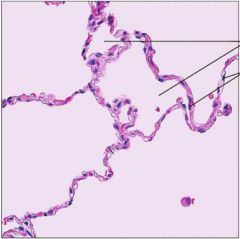
Describe (name, function, location) |
|
|
Name - simple cuboidal epithelium Function - secretion and absorption Location - kidney tubules, small glands |
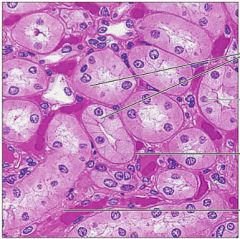
Describe (name, function, location) |
|
|
Name - simple columnar epithelium Function - absorption, secretion of mucus and enzymes Location - digestive tract (nonciliated), small bronchi, uterus (ciliated) |
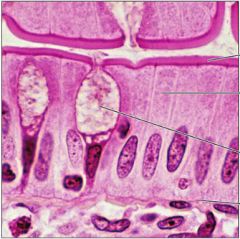
Describe (name, function, location) |
|
|
Name - pseudostratified columnar epithelium Function - secretion and propulsion of mucus Location - upper respiratory tract (ciliated), sperm ducts (nonciliated) |
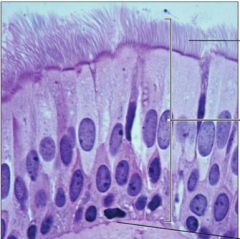
Describe (name, function, location) |
|
|
Name - stratified squamous epithelium Function - protects underlying tissues Location - epidermis (keratinized); esophagus, mouth, and vagina (nonkeratinized) |

Describe (name, function, location) |
|
|
Name - transitional epithelium Function - stretches readily for urine Location - ureters, bladder, urethra |
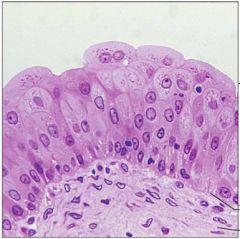
Describe (name, function, location) |
|
|
Name - loose connective areolar Function - cushions organs, houses macrophages, holds fluid Location - under epithelia, packages organs, surrounds capillaries |

Describe (name, function, location) |
|
|
Name - loose connective adipose Function - fuel storage, insulation, protection Location - under skin, abdomen, around kidneys and eyeballs, breasts |
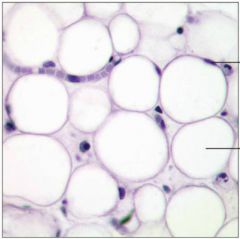
Describe (name, function, location) |
|
|
Name - loose connective reticular Function - internal skeleton supporting cells Location - lymphoid organs |
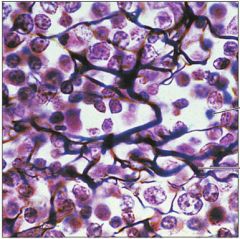
Describe (name, function, location) |
|
|
Name - dense connective regular Function - attaches muscles and bones, tensile strength in one direction Location - tendons, ligaments |
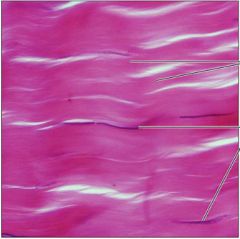
Describe (name, function, location) |
|
|
Name - dense connective irregular Function - tensile strength in many directions Location - fibrous capsules of organs and joints, dermis |
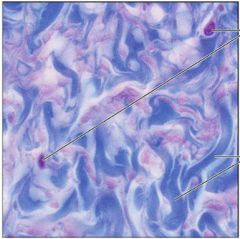
Describe (name, function, location) |
|
|
Name - dense connective elastic Function - tissue recoil after stretching, blood flow Location - large arteries, bronchial tubes, certain ligaments of the vertebral column |
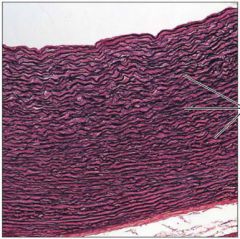
Describe (name, function, location) |
|
|
Name - hyaline cartilage Function - support and reinforcement, resilient cushion Location - ends of long bones, ribs, nose, trachea, larynx, embryonic skeleton |
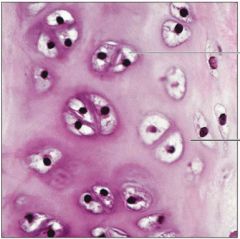
Describe (name, function, location) |
|
|
Name - elastic cartilage Function - maintains shape while allowing flexibility Location - external ear (pinna), epiglottis |

Describe (name, function, location) |
|
|
Name - fibrocartilage Function - great tensile strength absorbs compressive shock Location - intervertebral discs, knee joints |
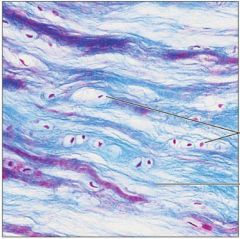
Describe (name, function, location) |
|
|
Name - osseous tissue (bone) Function - support and protection, levers for muscles Location - bones |
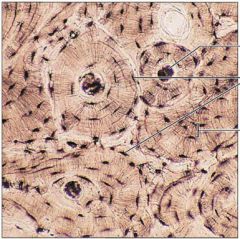
Describe (name, function, location) |
|
|
Name - blood Function - transport substances Location - within blood vessels |
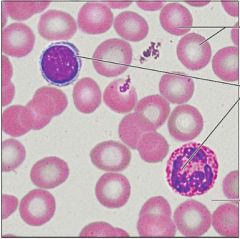
Describe (name, function, location) |
|
|
Name - skeletal muscle Function - movement, maniuplation, facial expression Location - muscles attached to bone or skin |
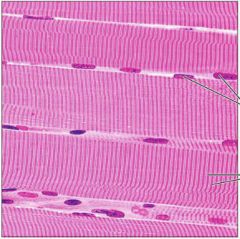
Describe (name, function, location) |
|
|
Name - cardiac muscle Function - propels blood Location - walls of the heart |
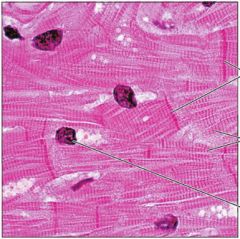
Describe (name, function, location) |
|
|
Name - smooth muscle Function - propels substances along passageways Location - walls of hollow organs |
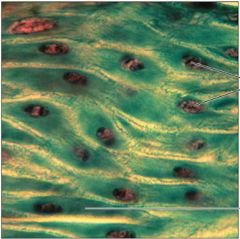
Describe (name, function, location) |
|
|
Name - nervous tissue Function - transmits electrical signals Location - brain, spinal cord, nerves |
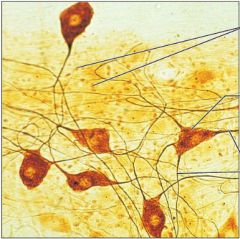
Describe (name, function, location) |

